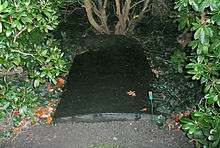Friedrich Kaulbach (painter)

Friedrich Wilhelm Christian Theodor Kaulbach (born July 8, 1822 in Bad Arolsen , † September 17, 1903 in Hanover ) was a German painter .
Life
Friedrich Kaulbach was a cousin and from 1839 a pupil of Wilhelm von Kaulbach , the first known member of this famous family of painters, and the father of its most famous representative, the Bavarian painter prince Friedrich August .
After a visit to Venice in 1844, he separated from his teacher and, by 1848, painted his first independent painting Adam and Eve find their son Abel slain . As a result, he was offered a professorship at the Munich Art Academy , which he did not follow. In 1850 he traveled to Paris , where he painted more historical pictures and also accepted orders for portraits. In 1850 he was commissioned by King Maximilian II of Bavaria to paint the picture of Charlemagne's coronation for the Maximilianeum ; the picture was completed in 1861.
In 1856, Kaulbach was called to Hanover as court painter by King George V , whom he portrayed several times, and received a professorship at the Hanover Polytechnic . As such, he taught, among others, the later graphic artist Heinrich Mittag . Kaulbach became the preferred portrait painter of the local aristocracy. The king gave him his own studio and residential building, which the Hanoverian architect Christian Heinrich Tramm built in 1857-60 at Waterloostraße 1 for Kaulbach (the listed building is, although disfigured, still available today as part of the Waterloo beer garden). Kaulbach's daughter, the writer Isidore Kaulbach , described life in her father's house in her memoirs (1931), in which u. a. Johannes Brahms , Clara Schumann , Franz Liszt , Joseph Joachim , Ernst von Wildenbruch and Anton Rubinstein frequented.
His numerous portraits, including those of the Empress of Austria , the German Crown Prince, Prince Albrecht, the Count and Countess Stolberg, are extraordinarily detailed, but often contain a slightly theatrical exaggeration, superficial elegance and dull color, in keeping with the taste of the time. He works best in portraits of women. Kaulbach received the small gold medal from the Berlin Art Academy and was made a full member of the same; at the Vienna World Exhibition in 1873 he was awarded the medal.
Friedrich Kaulbach's grave can be found in the Engesohde city cemetery in Hanover. Kaulbach's sons Friedrich August von Kaulbach and Anton Kaulbach also became painters, as did his daughter Antonie Kaulbach , who became a painter.
Works
- Adam and Eve find their son Abel slain (1848, Museum of Fine Arts , Leipzig)
- Coronation of Charlemagne (1861, Maximilianeum , Munich)
- Amtsrat Julius von Bandel (1898), oil painting
literature
- Isidore Kaulbach: Friedrich Kaulbach. Memories of my father's house . Mittler, Berlin 1931.
- Evelyn Lehmann / Elke Riemer: The Kaulbachs. A family of artists from Arolsen. Arolsen: Waldeck Historical Society 1978.
- Henning Rischbieter: Hannoversches Lesebuch or: What was written, printed and read in Hanover and about Hanover . Vol. 2: 1850-1950. Schlueter. 2nd edition Hannover 1991, pp. 102-105 (with excerpts from Isidore Kaulbach's memoirs). ISBN 3-87706-359-4
- Wilhelm Rothert : General Hanover Biography Volume 1: Hanoverian men and women since 1866 , Sponholtz, Hanover 1912, pp. 170–175
- Hugo Thielen in: Dirk Böttcher , Klaus Mlynek, Waldemar R. Röhrbein, Hugo Thielen: Hannoversches Biographisches Lexikon . From the beginning to the present. Schlütersche, Hannover 2002, ISBN 3-87706-706-9 , p. 195.
See also
Web links
- Literature by and about Friedrich Kaulbach in the catalog of the German National Library
- Family tree of the Kaulbach family on bad-arolsen.de (PDF; 872 kB)
Individual evidence
- ↑ Family tree of the Kaulbach family on bad-arolsen.de
- ^ Hugo Thielen : Noon, Heinrich. In: Klaus Mlynek, Waldemar R. Röhrbein (eds.) U. a .: City Lexicon Hanover . From the beginning to the present. Schlütersche, Hannover 2009, ISBN 978-3-89993-662-9 , p. 446.
| personal data | |
|---|---|
| SURNAME | Kaulbach, Friedrich |
| ALTERNATIVE NAMES | Kaulbach, Friedrich Wilhelm Christian Theodor (full name) |
| BRIEF DESCRIPTION | German painter |
| DATE OF BIRTH | July 8, 1822 |
| PLACE OF BIRTH | Arolsen |
| DATE OF DEATH | 17th September 1903 |
| Place of death | Hanover |


